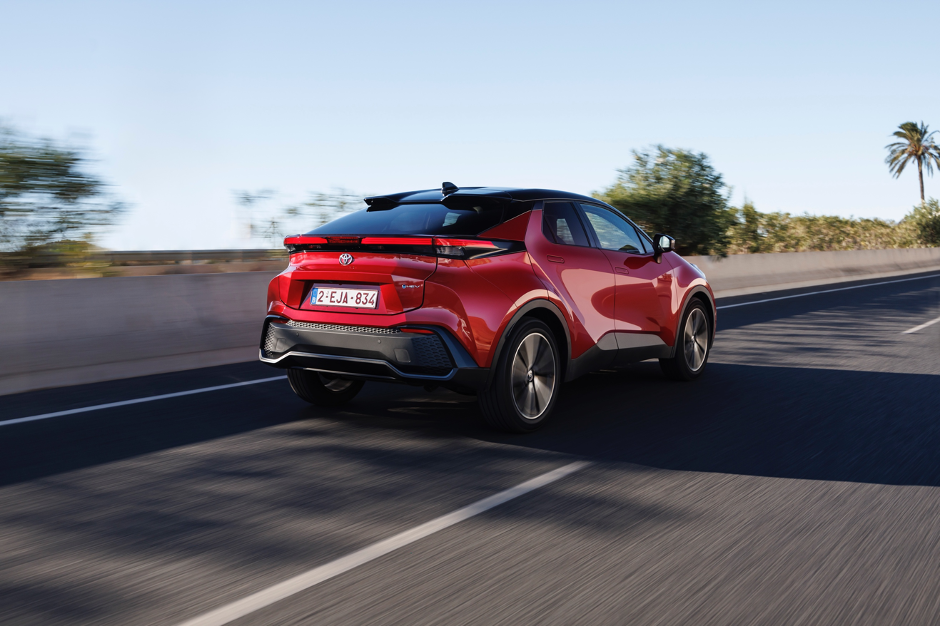Toyota C-HR 2024: Surprised by Toyota’s Compact SUV

Seven years after its initial launch, the Toyota C-HR returns with a bolder second generation, promising to blend style, technology, and efficiency. We tested the 2.0 hybrid model, the most powerful version before the arrival of the PHEV. So, does the new C-HR live up to its reputation? Here’s our verdict after a week of urban and suburban driving.
Design: Enhanced Visual Boldness
The Toyota C-HR 2024 makes no compromises on its distinctive style. At first glance, its resolutely modern look, inspired by the Prius and Aygo X Prologue, grabs attention. With slightly reduced dimensions (4.36 m in length, 3 cm shorter than the previous generation), this SUV retains a dynamic profile with sharp lines and a unique light signature. A special mention goes to the backlit logo at the rear, a feature that emphasizes its futuristic character.
In its bi-tone configuration, the C-HR plays the contrast card with impeccable finishes and bold touches like flush door handles. However, a minor downside is the noisy mechanism of these handles, which can be surprising during automatic locking.
While this design is a success, it doesn’t compromise on interior comfort. That said, the rear windows remain narrow, limiting brightness and visibility. Despite these constraints, the C-HR remains one of the most recognizable and elegant SUVs in its class.


Interior: Comfort and Technology in Harmony
Inside, the Toyota C-HR offers a modern and immersive layout. The dashboard wraps around the driver, while ambient lighting adjusts throughout the day, shifting from cool tones in the morning to warmer hues in the evening. This futuristic touch, albeit a bit gimmicky, enhances the cabin’s overall appeal.
At the center, a 12.3-inch touchscreen provides a responsive interface with wireless Android Auto and Apple CarPlay. Thankfully, essential physical controls, such as for climate settings, have been retained—a simplicity many competitors have abandoned.
However, rear space remains the SUV’s weak point. Taller passengers (over 1.75 m) might find it cramped, despite a panoramic roof that slightly improves the sense of space. As for the trunk, it offers a modest capacity of 364 liters in the 2.0 hybrid version, which falls short of the best in the segment.


Powertrain: Fifth-Generation Hybrid
The Toyota C-HR 2024 introduces the fifth generation of the automaker’s hybrid technology, a notable improvement in efficiency and driving comfort. We tested the 2.0 hybrid version, which delivers 198 horsepower thanks to a 152 hp gasoline engine and a 111 hp electric motor.
This powertrain enables brisk acceleration (0 to 100 km/h in 8.1 seconds) while remaining surprisingly efficient. In mixed driving conditions, we recorded an average consumption of 5.0 l/100 km, an impressive figure for an SUV with this level of power.
However, the CVT transmission, true to Toyota’s philosophy, remains polarizing. In calm driving, it offers unmatched smoothness, ideal for daily use. But under harder acceleration, the infamous « rubber band » effect persists, producing an unpleasant noise and a sense of sluggishness. This could frustrate drivers seeking a more dynamic experience.
On the Road: Balancing Comfort and Agility
On the road, the Toyota C-HR impresses with its versatility. In urban environments, its light steering and well-tuned suspension deliver remarkable driving comfort. The improved chassis rigidity minimizes body roll in corners, ensuring stable and reassuring handling.
On winding roads, the C-HR 2.0 reveals enjoyable agility. The responsiveness of the electric motor partly compensates for the lack of engagement caused by the CVT. However, on wet or slippery surfaces, the front-wheel-drive version may show limitations in traction. For those seeking extra security, the AWD-i version is a worthwhile option, though its high price might deter some buyers.

Fuel Economy: A Strong Suit
Efficiency is undoubtedly one of the Toyota C-HR’s greatest strengths. In urban driving, we observed a real-world consumption of 4.9 l/100 km, close to the manufacturer’s claims. Even on highways, where hybrids often struggle, the SUV maintained a respectable average of 6.5 l/100 km.
Toyota continues to prove its unmatched expertise in hybrid systems, with seamless transitions between the combustion engine and the electric motor.
Price and Verdict: Style Comes at a Cost
The Toyota C-HR 2024 starts at €34,900 for the 1.8 Dynamic version, while the 2.0 hybrid model we tested, in the high-end Collection Première trim, reaches €44,900. At this price, the C-HR offers a wealth of features, including a 12.3-inch screen, heated seats with faux leather/Alcantara upholstery, and a power tailgate.
Our opinion? The Toyota C-HR 2024 retains everything that made the first generation successful: bold design, efficient hybrid powertrain, and pleasant driving comfort. However, compromises on interior space and the CVT transmission limit its appeal for those seeking pure driving excitement.
For buyers prioritizing style and efficiency in a compact urban SUV, the Toyota C-HR remains an excellent choice. However, those looking for more space or a sportier driving experience might consider alternatives.
Pros:
- Distinctive and bold design
- Remarkable urban fuel efficiency
- Comfort and smooth driving experience
Cons:
- Limited rear space
- High price for top trims
